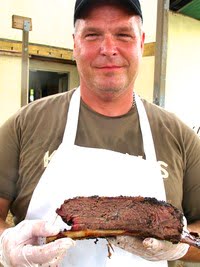
Beef ribs are in the spotlight lately. It’s all about the flavor: a well-cooked beef rib is just as succulent as a perfectly cooked brisket, but with a softer, silkier texture. Louis Mueller’s in Taylor has been cooking beef ribs since they opened. And Pecan Lodge in Dallas has gotten a lot of noteriety for theirs lately too. Ronnie Killen plans to serve them when his new barbecue joint opens in Pearland a few months from now.

Ronnie Killen has resorted to using the numbers from the North American Meat Packers meat buyers’ guide to specify which ones he is talking about. The smaller ones are called chuck short ribs (NAMP 130), and they are easily carved into just the right size for a single serving. The giant ones are called plate short ribs (NAMP 123A), and Killen’s sells these by the pound. The 123A Ronnie Killen is holding in the photo weighs a pound and half—at $12 a pound, that’s an $18 beef rib.

